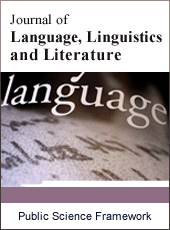Journal of Language, Linguistics and Literature
Articles Information
Journal of Language, Linguistics and Literature, Vol.5, No.1, Mar. 2019, Pub. Date: May 17, 2019
An Analysis of Li He’s Poetry from the Perspective of Sub World Theory
Pages: 24-31 Views: 2261 Downloads: 911
[01]
Qing Wang, School of Teacher and Education, Nanjing Normal University, Nanjing, China.
The Sub World Theory is the third theoretical part of Text World Theory which proposed by Professor Paul Werth and further developed by Joanna Gavins. It is concerned with how language, as well as the context in which it is produced, leads the participants in the discourse to build mental representations for original events. In fact, the Text World Theory originates from the traditional Cognitive Linguistics which is the theory about the production and receiving of the discourse. The Sub World Theory has been applied widely in the literary text analysis to explain how fictional words are created and how they develop. According to this theory, “sub world” can be divided into three levels: the Deictic Sub World, the Attitudinal Sub World and the Epistemic Sub World. Li He was a well-known and outstanding poet in Song Dynasty. If the achievements of literature and art are combined together, Li He is definitely the historical figure in ancient times. No one in the entire Chinese cultural history can keep pace with him. The purpose of this paper is to use the Sub World Theory make an analysis of classic Chinese poetry Li He’s works. The combination of the foreign theory and Chinese culture further promote the advancement of the cognitive poetics and enrich the analyzing methodologies for Chinese classical poems. Meanwhile, it is beneficial to Chinese traditional culture to appear on the international stage.
Deictic Sub-world, Attitudinal Sub-world, Epistemic Sub-world, Li He’s Poetry
[01]
Gavins, J& Ernestine L (2016). World Building: Discourse in the Mind. Bloomsbury Academic.
[02]
Gavins, J&S Gerard. (2003). Cognitive Poetics in Practice. London: Routledge.
[03]
Werth, P (1994). Extended Metaphor-a Text-World Account. Language and Literature, (3): 53-72.
[04]
Lahey, E (2004). All the World’s a Sub-world. Nottingham: Nottingham Linguistic Circular.
[05]
Verdonk, P (2008). Book Review: Text World Theory: An Introduction by Joanna Gavins. Language and Literature (2): 91-108.
[06]
Stockwell, P (2007). Cognitive Poetics and Literary Theory. Journal of Literary Theory (1): 57-62.
[07]
Canning, P (2017). Text World Theory and real world readers: From literature to life in a Belfast prison. Language and Literature (2): 172–187.
[08]
van der Bom, Isabelle (2015). Text World Theory and stories of self: a cognitive discursive approach to identity. PhD thesis, University of Sheffield.
[09]
M, Giovanelli (2013). Text World Theory and Keats’ Poetry, Bloomsbury Academic.
[10]
William, J. M (2012). Cognitive Poetics and Common Ground in a Multicultural Context: The Poetry of Zehra Cirak. The German Quarterly (85): 173-195.
[11]
Ruan Jing (2013). Text World Theory and Interpretation of Artistic Conceptions in Li Shang-yin’s Poetry from the Perspective of Cognitive Poetics. master thesis, University of Wuhan Polytechnics.
[12]
Zhou Shanshan (2017). Research on Theme Realization of Xin Qiji’s Song Lyrics from the Perspective of Text World Theory, master thesis, University of Wuhan Polytechnics.
[13]
Xin Li (2011). The Death Imagery in Li He’s Poetry, Literature Study (3): 4-8.
[14]
Fauconnier, G (1994). Mental spaces: aspects of meaning construction in natural language. London: Cambridge University Press.
[15]
Yunji Chen, Haiyong Wu (2004). Selected Poems of Li He. Shanghai: Classical Ancient Books Press.

ISSN Print: 2381-7054
ISSN Online: 2381-7062
Current Issue:
Vol. 6, Issue 1, March Submit a Manuscript Join Editorial Board Join Reviewer Team
ISSN Online: 2381-7062
Current Issue:
Vol. 6, Issue 1, March Submit a Manuscript Join Editorial Board Join Reviewer Team
| About This Journal |
| All Issues |
| Open Access |
| Indexing |
| Payment Information |
| Author Guidelines |
| Review Process |
| Publication Ethics |
| Editorial Board |
| Peer Reviewers |


